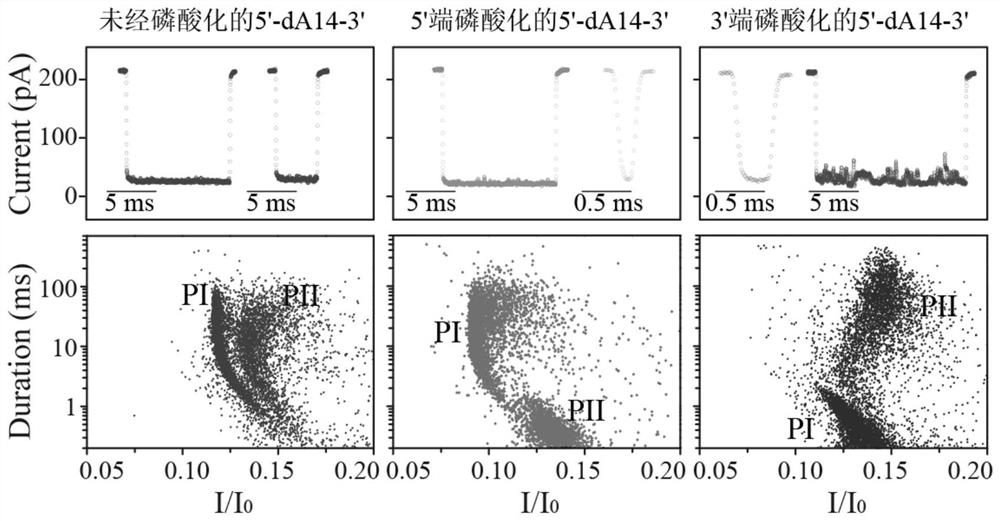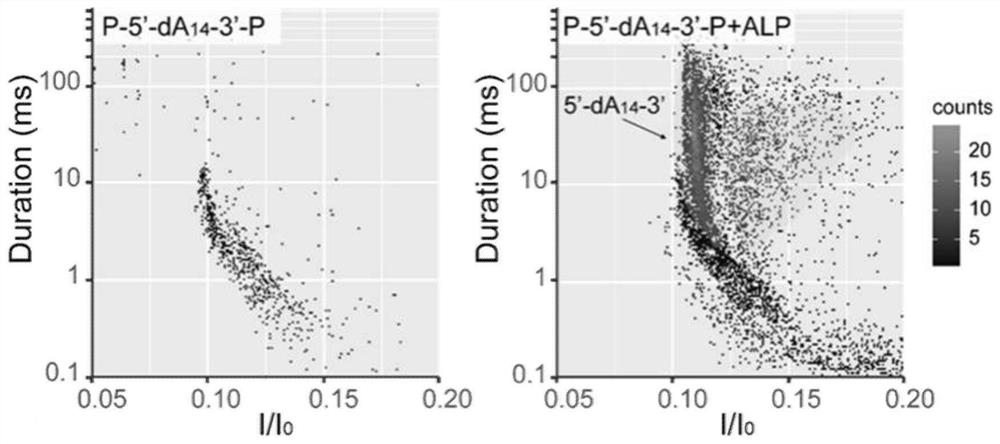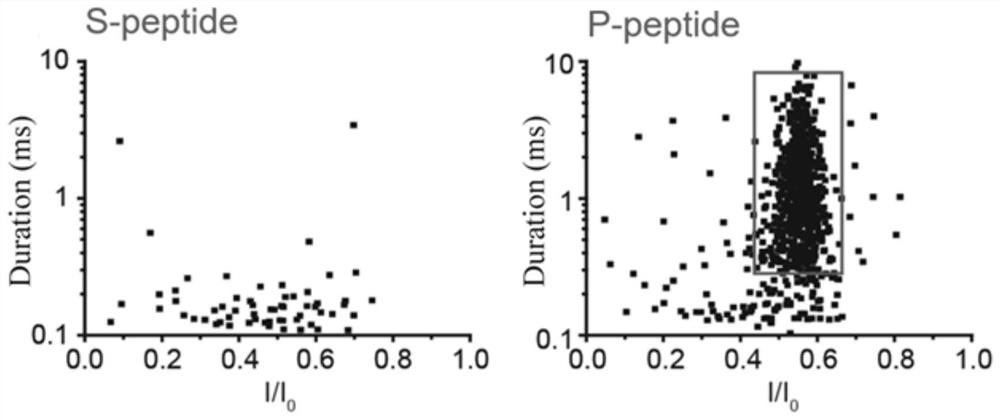Application of aerolysin nanopore channel in biological phosphorylation and related enzyme analysis
An aerolysin and nanopore technology, applied in the biological field, can solve the problems of insufficient sensitivity of phosphorylation state detection and weak interaction, and achieve real-time monitoring, high sensitivity and convenient detection
- Summary
- Abstract
- Description
- Claims
- Application Information
AI Technical Summary
Problems solved by technology
Method used
Image
Examples
Embodiment 1
[0046] Example 1: Nucleic acid phosphorylation / dephosphorylation detection
[0047] (1) Construct the aerolysin nanopore channel: Assemble the detection cell and add an electrolyte solution (Tris buffer, 1mol / L) with pH=8 at both ends of the detection cell, and place a 50 μm micropore in the detection cell Build a phospholipid bilayer at one end of the detection cell, add aerolysin to one end of the detection cell, and wait for it to form aerolysin nanopores on the phospholipid bilayer;
[0048] (2) Apply a voltage of 300mV at both ends of the aerolysin nanopore channel, add 10ul of the analyte (the amount to be added depends on the detection requirements, generally 1-100uL) into one end of the detection cell (Cis end), Driven by the potential, the analyte passes through the aerolysin nanopore to generate a blocking current signal and blocking current time;
[0049] (3) Comparing and analyzing the blocking current signal and the blocking current time to obtain the correspondi...
Embodiment 2
[0053] Embodiment 2: the detection of alkaline phosphatase
[0054] (1) Construct the aerolysin nanopore channel: assemble the detection cell and add MgCl-containing 2 Electrolyte solution (Tris buffer, 1mol / L) of pH=7.5, MgCl 2 The concentration is 20mmol / L, build a phospholipid bilayer at the 50μm micropore in the detection pool, add aerolysin at one end of the detection pool, and wait for it to form aerolysin on the phospholipid bilayer Nanopore;
[0055] (2) Apply a voltage of 100mV at both ends of the Aerolysin nanopore channel, add 10ul of the analyte to one end of the detection cell (Cis end), and the analyte passes through the Aeromonas lysate under the drive of the potential. Prime nanopores generate blocking current signals;
[0056] (3) Comparing and analyzing the blocking current signal and the blocking current time to obtain the corresponding detection information of the object to be tested.
[0057] The analytes are phosphorylated DNA strands (P-5'-dA 14 -3'...
Embodiment 3
[0060] Example 3: Detection of polypeptide phosphorylation
[0061] (1) Construct the aerolysin nanopore channel: assemble the detection cell and add MgCl-containing 2 Electrolyte solution (Tris buffer, 1mol / L) of pH=7.5, MgCl 2 The concentration is 20mmol / L, build a phospholipid bilayer at the 50μm micropore in the detection pool, add aerolysin at one end of the detection pool, and wait for it to form aerolysin on the phospholipid bilayer Nanopore;
[0062](2) Apply a voltage of 300mV at both ends of the nanochannel, add 10ul of the analyte to one end of the detection cell (Cis end), and under the drive of the potential, the analyte passes through the aerolysin nanopore to generate a blocking current Signal and blocking current time.
[0063] (3) Comparing and analyzing the blocking current signal and the blocking current time to obtain the corresponding detection information of the object to be tested.
[0064] The analyte uses LRRASLG as a model polypeptide, respectivel...
PUM
| Property | Measurement | Unit |
|---|---|---|
| Molecular weight | aaaaa | aaaaa |
Abstract
Description
Claims
Application Information
 Login to View More
Login to View More - R&D Engineer
- R&D Manager
- IP Professional
- Industry Leading Data Capabilities
- Powerful AI technology
- Patent DNA Extraction
Browse by: Latest US Patents, China's latest patents, Technical Efficacy Thesaurus, Application Domain, Technology Topic, Popular Technical Reports.
© 2024 PatSnap. All rights reserved.Legal|Privacy policy|Modern Slavery Act Transparency Statement|Sitemap|About US| Contact US: help@patsnap.com










